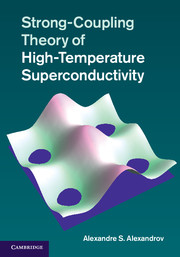Book contents
- Frontmatter
- Contents
- Preface
- 1 Coulomb and Fröhlich interactions
- 2 Small polarons
- 3 Inverse-coupling expansion technique
- 4 High-temperature superconductivity
- 5 Converting boson–fermion mixtures
- 6 Superconductivity from repulsion: Theoretical constraints
- 7 Theory and experiment: Confirmed predictions
- 8 Experiments explained: Normal state
- 9 Experiments explained: Superconducting state
- 10 Further predictions
- References
- Index
9 - Experiments explained: Superconducting state
Published online by Cambridge University Press: 05 May 2013
- Frontmatter
- Contents
- Preface
- 1 Coulomb and Fröhlich interactions
- 2 Small polarons
- 3 Inverse-coupling expansion technique
- 4 High-temperature superconductivity
- 5 Converting boson–fermion mixtures
- 6 Superconductivity from repulsion: Theoretical constraints
- 7 Theory and experiment: Confirmed predictions
- 8 Experiments explained: Normal state
- 9 Experiments explained: Superconducting state
- 10 Further predictions
- References
- Index
Summary
Specific heat anomaly
Bose liquids (or more precisely 4He) show the characteristic λ-point singularity of their specific heat, while superfluid Fermi liquids like the BCS superconductors exhibit a second-order phase transition accompanied by a finite jump in their specific heat [7]. It was established beyond doubt [277, 278, 279, 280, 281] that the anomaly in high-Tc cuprates differs qualitatively from the BSC prediction. As was stressed by Salamon et al. [282] the heat capacity is logarithmic near the transition, and consequently cannot be adequately treated by the mean-field BCS theory even including Gaussian fluctuations. In particular, estimates using the Gaussian fluctuations yield an unusually small coherence volume comparable with the unit cell volume [278]. Comparison of the specific heat of a few high-Tc superconductors with that of 4He found a perfect fit [283], where the λ-like specific heat anomaly points to real-space pairing.
It has also been observed that the resistive transition reveals an upper critical field with increasingly negative gradient on cooling, Section 7.1, in cuprate and some other unconventional superconductors. However, the λ-point of the specific heat scarcely shifts with applied magnetic field [284]. Either phenomenon is highly unusual in itself but also appears to be irreconcilable with the other under the BCS framework. The bipolaron theory reconciled these observations [151, 287].
Calculations of the specific heat of charged bosons in a magnetic field require an analytical DOS, N(E, B), of a particle scattered by other particles and/or by the random potential. One can use the DOS in the magnetic field with impurity scattering, Eq. (7.16), as in Section 7.1.
- Type
- Chapter
- Information
- Strong-Coupling Theory of High-Temperature Superconductivity , pp. 115 - 147Publisher: Cambridge University PressPrint publication year: 2013



